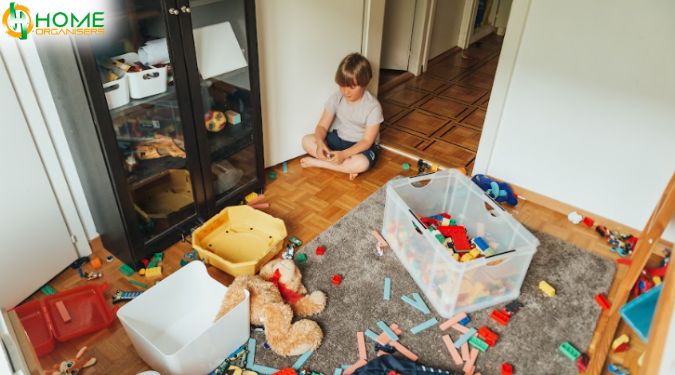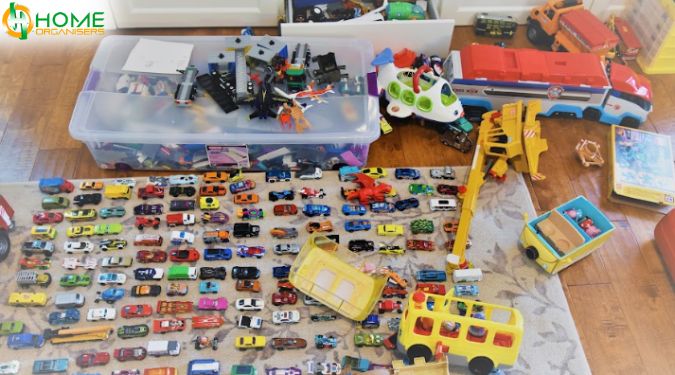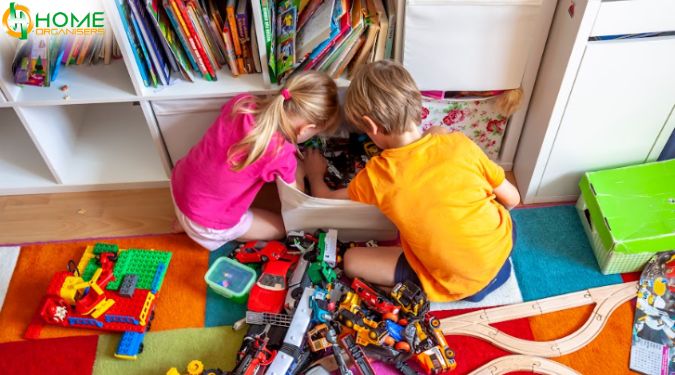Kids’ rooms are often the messiest space in a home. From overflowing toy bins to clothes scattered across the floor, organising and decluttering them can seem impossible for even the most seasoned home organisers. However, the truth is, with the right approach, you can transform a chaotic kids’ room into a functional, organised, and even enjoyable space for both kids and parents.
In this blog, we’ll explore some essential home organising techniques for kids’ bedrooms that can help you efficiently organise kids’ bedrooms. We’ll reference a comprehensive DIY guide for kids’ bedroom decluttering, which provides step-by-step strategies for tackling clutter, sorting belongings, and maintaining a clean and organised room. Whether you’re a professional home organiser or simply looking for ways to tackle a messy room, these techniques will give you the tools you need to create a calm, stress-free environment.
1. Start with Clear Goals
Setting clear and achievable goals is one of the most essential steps in organising kids’ bedrooms. Organising a child’s room can feel overwhelming if you don’t have a plan, so start by defining what you want to achieve.
Ask yourself:
- What areas need the most attention? Is it the toy clutter, the overflowing wardrobe, or the piles of books?
- What’s the most important task? Are you looking for a quick tidy-up or a complete room overhaul?
- How much time do you realistically have? Consider breaking the task into smaller sessions if necessary.
By setting clear goals, you can tackle the project in manageable steps and avoid feeling like you’re drowning in the mess.
2. Sort Everything: The Keep, Donate, Recycle, Toss Method
One of the best techniques for decluttering kids’ rooms efficiently is sorting everything into four categories: Keep, Donate, Recycle, and Toss. This method helps make decisions more manageable, especially when dealing with items with sentimental value or emotional attachments.
- Keep: These are items your child uses regularly or honestly loves. Focus on things still in good condition and have a clear purpose in the room.
- Donate: Items in good condition but no longer needed or loved should be set aside for donation. Please encourage your child to part with toys they’ve outgrown or books they’ve read repeatedly. Frame the donation process as an opportunity to share with others, which can make it a positive experience.
- Recycle: Put items that can’t be donated but can still be repurposed, such as broken toys or worn-out clothes, in the recycle pile. Teaching kids to recycle helps them learn about sustainability.
- Toss: Anything broken beyond repair, missing pieces, or no longer functional should go into the trash. Be firm but empathetic when parting with these items.

3. Create Kid-Friendly Storage Solutions
Once you’ve sorted everything, the next step is organising what’s left. Kids’ rooms are often small, so efficient kid-friendly storage solutions for small rooms are key. The goal is to maximise space without overwhelming your child with complicated systems.
Some essential practical storage ideas for kids’ room organisation to consider:
- Bins and Baskets are ideal for toys, books, or clothes. Choose clear or colour-coded bins so that kids can quickly identify the contents. Use baskets for frequently used items that need to be kept off the floor.
- Shelves: Shelving units display toys, books, and keepsakes. Ensure the shelves are within your child’s reach so they can quickly put things back where they belong. Label shelves with images or words to help younger kids track where things go.
- Under-Bed Storage: Use the space under the bed for out-of-season clothes, extra toys, or spare bedding. Rolling bins or vacuum-sealed bags are great for easy access and saving space.
- Hanging Organisers: Utilise vertical space with hanging organisers for shoes, accessories, or small toys. These can be hung on the back of the door or inside the closet to keep things neat and accessible.
- Multi-Functional Furniture: Furniture with built-in storage, such as beds with drawers or ottomans with hidden compartments, is a great way to save space while still keeping items organised.
4. Involve the Kids in the process
Decluttering and organising a kid’s room is an excellent opportunity to teach valuable life skills. By involving your child in the process, you help them feel empowered and instil a sense of responsibility for maintaining an organised space.
- Make It Fun: Turn the decluttering process into a game or challenge. Set a timer and see how many items can be sorted in 10 minutes. Offer praise and small rewards for their efforts. Kids are likelier to engage if the experience feels less like a chore.
- Use Visual Aids: Create simple charts or visual guides to help kids understand the process. For example, you can print a chart with categories like “Keep,” “Donate,” “Toss,” and “Recycle.” If your child is younger, using pictures alongside words will help them grasp the task.
- Set Realistic Expectations: Be patient and realistic with your child. Let them know they can keep their favourite toys and donate things they no longer use. This process teaches them decision-making, generosity, and letting go of unnecessary items.

5. Declutter in Zones
A messy room can feel overwhelming if you try to declutter everything completely. Instead, break the task down into smaller zones or categories. Focus on one area or item type to avoid feeling lost in the clutter.
Here are some standard best methods for sorting toys and clothes in kids’ rooms:
- Drawers: Empty each drawer, sort the items, and only return what belongs. Consider using drawer dividers to keep everything in its place.
- Shelves: Start with the most cluttered shelf and work your way down. Sort books, toys, and other items. Display the most-loved books or toys and store others out of sight.
- Closets: Separate clothes into categories like “fits now,” “too small,” and “seasonal.” Store off-season clothes in bins or vacuum-sealed bags to create more room in the closet.
- Floor Space: Begin by clearing visible clutter so you can walk around easily. Once the floor is clear, you can assess other room areas with a clearer mind.
6. Teach Kids to Let Go of Sentimental Items
Sentimental items can be some of the hardest things to declutter. Kids often attach emotions to their toys, artwork, or gifts, making it difficult to let go. However, learning to part with sentimental items is an essential skill that can reduce future clutter and promote healthy decision-making.
- Memory Boxes: Create a designated “memory box” for your child to store unique keepsakes. Please encourage them to choose only the most essential items. This will help reduce the tendency to keep everything.
- Take Photos: For items that hold sentimental value but aren’t practical, take a photo before letting them go. Creating a digital memory book can help preserve the memories without cluttering the room.
- Focus on the Future: Remind your child that letting go of items makes room for new experiences and memories. This mindset shift can make parting with sentimental items less like a loss.
7. Establish Habits for Maintaining the Organization
Once you’ve decluttered and organised the room, it’s important to establish habits to maintain the organisation over time. A clutter-free room doesn’t stay that way without regular upkeep.
- Daily Clean-Up: Encourage your child to spend a few minutes each day tidying up. A quick 5-minute clean-up before bed can prevent the mess from building up.
- Weekly Review: Set aside time each week to review the room, put away stray items, and ensure everything is in its place. This will prevent clutter from accumulating.
- Seasonal Review: Every few months, reassess what items are being used and what’s no longer needed. Rotate toys and clothes seasonally to keep things fresh.

Conclusion
Decluttering and organising a kid’s room is not just about tidying up; it’s about creating a space where your child can play, sleep, and grow without feeling overwhelmed by chaos.
You can transform a cluttered room into a calm, organised oasis by using these essential home organising techniques for kids’ bedrooms—setting goals, sorting items, involving kids in the process, and creating effective storage solutions for kids’ room organisation. More importantly, you’ll teach your child valuable organisational skills that will benefit them for years.
As you create a clutter-free kids’ bedroom, you’ll find that an organised space promotes productivity, emotional well-being, and a sense of accomplishment for your child.
By implementing these practical storage ideas for kids’ room organisation and teaching your child how to make decluttering fun for kids in their room, you can foster an environment that encourages lifelong habits of cleanliness and order.
By implementing effective strategies for organising sentimental items in kids’ rooms, you’ll not only help your child part with unnecessary possessions but also maintain a room that reflects their personality without the overwhelming clutter.
Ready to transform your kids’ bedroom into a clutter-free haven? Contact us today for expert organising tips and solutions!
Call us at 03 8583 9103 or email nancy@homeorganisers.com.au. Visit our website at homeorganisers.com.au to learn more.


